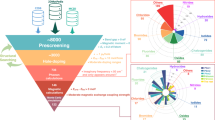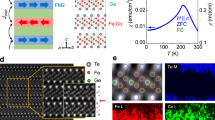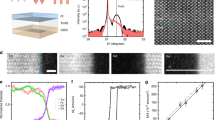Abstract
Future spintronics technologies based on diluted magnetic semiconductors (DMSs) will rely heavily on a sound understanding of the microscopic origins of ferromagnetism in such materials. Discoveries of room-temperature ferromagnetism in wide-bandgap DMSs hold great promise, but this ferromagnetism remains poorly understood. Here we demonstrate a close link between the electronic structures and polarity-dependent high-TC ferromagnetism of TM2+:ZnO DMSs, where TM2+ denotes 3d transition metal ions. Trends in ferromagnetism across the 3d series of TM2+:ZnO DMSs predicted from the energies of donor- and acceptor-type excited states reproduce experimental trends well. These results provide a unified basis for understanding both n- and p-type ferromagnetic oxide DMSs.
This is a preview of subscription content, access via your institution
Access options
Subscribe to this journal
Receive 12 print issues and online access
$259.00 per year
only $21.58 per issue
Buy this article
- Purchase on Springer Link
- Instant access to full article PDF
Prices may be subject to local taxes which are calculated during checkout





Similar content being viewed by others
References
Dietl, T., Ohno, H., Matsukura, F., Cibert, J. & Ferrand, D. Zener model description of ferromagnetism in zinc-blende magnetic semiconductors. Science 287, 1019–1022 (2000).
Sato, K. & Katayama-Yoshida, H. First principles materials design for semiconductor spintronics. Semicond. Sci. Technol. 17, 367–376 (2002).
Pearton, S. J., Heo, W. H., Ivill, M., Norton, D. P. & Steiner, T. Dilute magnetic semiconducting oxides. Semicond. Sci. Technol. 19, R59–R74 (2004).
Look, D. C. & Claflin, B. P-type doping and devices based on ZnO. Phys. Status Solidi B 241, 624–630 (2004).
Ghosh, S. et al. Room-temperature spin coherence in ZnO. Appl. Phys. Lett. 86, 232507 (2005).
Kittilstved, K. R., Norberg, N. S. & Gamelin, D. R. Chemical manipulation of high-TC ferromagnetism in ZnO diluted magnetic semiconductors. Phys. Rev. Lett. 94, 147209 (2005).
Lim, S.-W., Jeong, M.-C., Ham, M.-H. & Myoung, J.-M. Hole-mediated ferromagnetic properties in Zn1−xMnxO thin films. Jpn J. Appl. Phys. 43, L280–L283 (2004).
Ivill, M., Pearton, S. J., Norton, D. P., Kelly, J. & Hebard, A. F. Magnetization dependence on electron density in epitaxial ZnO thin films codoped with Mn and Sn. J. Appl. Phys. 97, 053904 (2005).
Norberg, N. S. et al. Synthesis of colloidal Mn2+:ZnO quantum dots and high-TC ferromagnetic nanocrystalline thin films. J. Am. Chem. Soc. 126, 9387–9398 (2004).
Saeki, H., Tabata, H. & Kawai, T. Magnetic and electric properties of vanadium doped ZnO films. Solid State Commun. 120, 439–443 (2001).
Schwartz, D. A. & Gamelin, D. R. Reversible 300 K ferromagnetic ordering in a diluted magnetic semiconductor. Adv. Mater. 16, 2115–2119 (2004).
Venkatesan, M., Fitzgerald, C. B., Lunney, J. G. & Coey, J. M. D. Anisotropic ferromagnetism in substituted zinc oxide. Phys. Rev. Lett. 93, 177206 (2004).
Dietl, T. Dilute magnetic semiconductors: Functional ferromagnets. Nature Mater. 2, 646–648 (2003).
Coey, J. M. D., Venkatesan, M. & Fitzgerald, C. B. Donor impurity band exchange in dilute ferromagnetic oxides. Nature Mater. 4, 173–179 (2005).
Ueda, K., Tabata, H. & Kawai, T. Magnetic and electric properties of transition-metal-doped Zno films. Appl. Phys. Lett. 79, 988–990 (2001).
Kittilstved, K. R. & Gamelin, D. R. Activation of high-TC ferromagnetism in Mn2+-doped ZnO using amines. J. Am. Chem. Soc. 127, 5292–5293 (2005).
Petit, L., Schulthess, T. C., Svane, A., Temmerman, W. M. & Szotek, Z. Valencies of Mn impurities in ZnO. Mater. Res. Soc. Symp. Proc. E 825, G2.9.1-6 (2004).
Wang, Q., Sun, Q., Jena, P. & Kawazoe, Y. Carrier-mediated ferromagnetism in N codoped (Zn,Mn)O (1010) thin films. Phys. Rev. B 70, 052408 (2004).
Bhattacharjee, A. K. Interactions between band electrons and transition-metal ions in diluted magnetic semiconductors. Phys. Rev. B 46, 5266–5273 (1992).
Kobayashi, M. et al. Characterization of magnetic components in the diluted magnetic semiconductor Zn1−xCoxO by X-ray magnetic circular dichroism. Phys. Rev. B 72, 201201 (2005).
Noras, J. M. & Allen, J. W. Photoionisation of nickel in ZnS and ZnSe. J. Phys. C 13, 3511–3521 (1980).
Heitz, R., Hoffmann, A. & Broser, I. Magneto-optics of Ni-bound shallow states in ZnS and CdS. Phys. Rev. B 48, 8672–8682 (1993).
Bishop, S. G., Robbins, D. J. & Dean, P. J. Evidence for exciton binding at Ni impurity sites in ZnSe. Solid State Commun. 33, 119–122 (1980).
Müller, B., Roussos, G. & Schulz, H.-J. Photoluminescence and excitation spectroscopy of Ni2+ and Ni+ centres in ZnS Crystals. J. Cryst. Growth 72, 360–363 (1985).
Juhl, A., Hoffmann, A., Bimberg, D. & Schulz, H.-J. Bound-exciton-related fine structure in charge transfer spectra of InP:Fe detected by calorimetric absorption spectroscopy. Appl. Phys. Lett. 50, 1292–1294 (1987).
Liu, W., Salley, G. M. & Gamelin, D. R. Spectroscopy of photovoltaic and photoconductive nanocrystalline Co2+-doped ZnO electrodes. J. Phys. Chem. B 109, 14486–14495 (2005).
Fleurov, V. N. & Kikoin, K. A. Amphoteric exciton trapping by 3d-impurities in A2B6 semiconductors. Solid State Commun. 42, 353–357 (1982).
Mizokawa, T. & Fujimori, A. Configuration-interaction description of transition-metal impurities in II–VI semiconductors. Phys. Rev. B 48, 14150–14156 (1993).
Blinowski, J., Kacman, P. & Dietl, T. Kinetic exchange vs. room temperature ferromagnetism in diluted magnetic semiconductors. Mater Res. Soc. Symp. Proc. 690, 109–114 (2002).
Fazzio, A., Caldas, M. J. & Zunger, A. Many-electron multiplet effects in the spectra of 3d impurities in heteropolar semiconductors. Phys. Rev. B 30, 3430–3455 (1984).
Langer, J. M., Delerue, C., Lannoo, M. & Heinrich, H. Transition-metal impurities in semiconductors and heterojunction band lineups. Phys. Rev. B 38, 7723–7739 (1988).
Weakliem, H. A. Optical spectra of Ni2+, Co2+, and Cu2+ in tetrahedral sites in crystals. J. Chem. Phys. 36, 2117–2140 (1962).
Schwartz, D. A., Norberg, N. S., Nguyen, Q. P., Parker, J. M. & Gamelin, D. R. Magnetic quantum dots: synthesis, spectroscopy, and magnetism of Co2+- and Ni2+-doped ZnO nanocrystals. J. Am. Chem. Soc. 125, 13205–13218 (2003).
Jørgensen, C. K. Electron transfer spectra. Prog. Inorg. Chem. 12, 101–158 (1970).
Lever, A. B. P. Inorganic Electronic Spectroscopy (Elsevier Science, Amsterdam, 1984).
Mizokawa, T., Nambu, T., Fujimori, A., Fukumura, T. & Kawasaki, M. Electronic structure of the oxide-diluted magnetic semiconductor Zn1−xMnxO . Phys. Rev. B 65, 085209 (2002).
Wong, W. C., McClure, D. S., Basun, S. A. & Kokta, M. R. Charge-exchange processes in titanium-doped sapphire crystals. I. Charge-exchange energies and titanium-bound excitons. Phys. Rev. B 51, 5682–5692 (1995).
Look, D. C., Hemsky, J. W. & Sizelove, J. R. Residual native shallow donor in ZnO. Phys. Rev. Lett. 82, 2552–2555 (1999).
Mulliken, R. S. Electronic population analysis on LCAO-MO molecular wave functions. II. Overlap populations, bond orders, and covalent bond energies. J. Chem. Phys. 23, 1841–1846 (1955).
Wolfsberg, M. & Helmholz, L. The spectra and electronic structure of the tetrahedral ions MnO4-, CrO4- -, and ClO4-. J. Chem. Phys. 20, 837–843 (1952).
Shklovskii, B. I. Hopping conduction in lightly doped semiconductors. Sov. Phys. Semicond. 6, 1053–1075 (1973).
Beschoten, B. et al. Magnetic circular dichroism studies of carrier-induced ferromagnetism in (Ga1−xMnx)As . Phys. Rev. Lett. 83, 3073–3076 (1999).
Bryan, J. D., Heald, S. M., Chambers, S. A. & Gamelin, D. R. Strong room-temperature ferromagnetism in Co2+-doped TiO2 made from colloidal nanocrystals. J. Am. Chem. Soc. 126, 11640–11647 (2004).
Archer, P. I., Radovanovic, P. V., Heald, S. M. & Gamelin, D. R. Low-temperature activation and deactivation of high-TC ferromagnetism in a new diluted magnetic semiconductor: Ni2+-doped SnO2 . J. Am. Chem. Soc. 127, 14479–14487 (2005).
Bryan, J. D., Santangelo, S. A., Keveren, S. C. & Gamelin, D. R. Activation of high-TC ferromagnetism in Co2+:TiO2 and Cr3+:TiO2 nanorods and nanocrystals by grain boundary defects. J. Am. Chem. Soc. 127, 15568–15574 (2005).
Acknowledgements
Financial support from the NSF (PECASE DMR-0239325 and ECS-0224138), the Research Corporation (Cottrell Scholar), the Dreyfus Foundation (Teacher/Scholar), and the NSF-IGERT program at U.W. (to W.K.L.) is gratefully acknowledged.
Author information
Authors and Affiliations
Corresponding author
Ethics declarations
Competing interests
The authors declare no competing financial interests.
Supplementary information
Supplementary information
Supplementary tables S1, S2 and S3; supplementary figures S1 and S2 (PDF 245 kb)
Rights and permissions
About this article
Cite this article
Kittilstved, K., Liu, W. & Gamelin, D. Electronic structure origins of polarity-dependent high-TC ferromagnetism in oxide-diluted magnetic semiconductors. Nature Mater 5, 291–297 (2006). https://doi.org/10.1038/nmat1616
Received:
Accepted:
Published:
Issue Date:
DOI: https://doi.org/10.1038/nmat1616
This article is cited by
-
Electronic, elastic, and thermodynamic properties of Cd0.75TM0.25S (TM = Os or Ir) alloys with the TB-mBJ approach and hybrid density functional (HSE06)
Indian Journal of Physics (2024)
-
Enhanced Ferromagnetism in Nano-sized Sn0.85Co0.10Fe0.03Mn0.02O2 Dilute Magnetic Semiconductor Synthesised by Sol–Gel Method
Journal of Superconductivity and Novel Magnetism (2024)
-
Coupling between magnetic order and charge transport in a two-dimensional magnetic semiconductor
Nature Materials (2022)
-
Growth of Co-doped ZnO thin films exhibiting room temperature ferromagnetism using a low-cost spray pyrolysis technique
Bulletin of Materials Science (2022)
-
Oxygen defects induced tailored optical and magnetic properties of FexCr2−xO3 (0 ≤ x ≤ 0.1) nanoparticles
Applied Physics A (2022)



